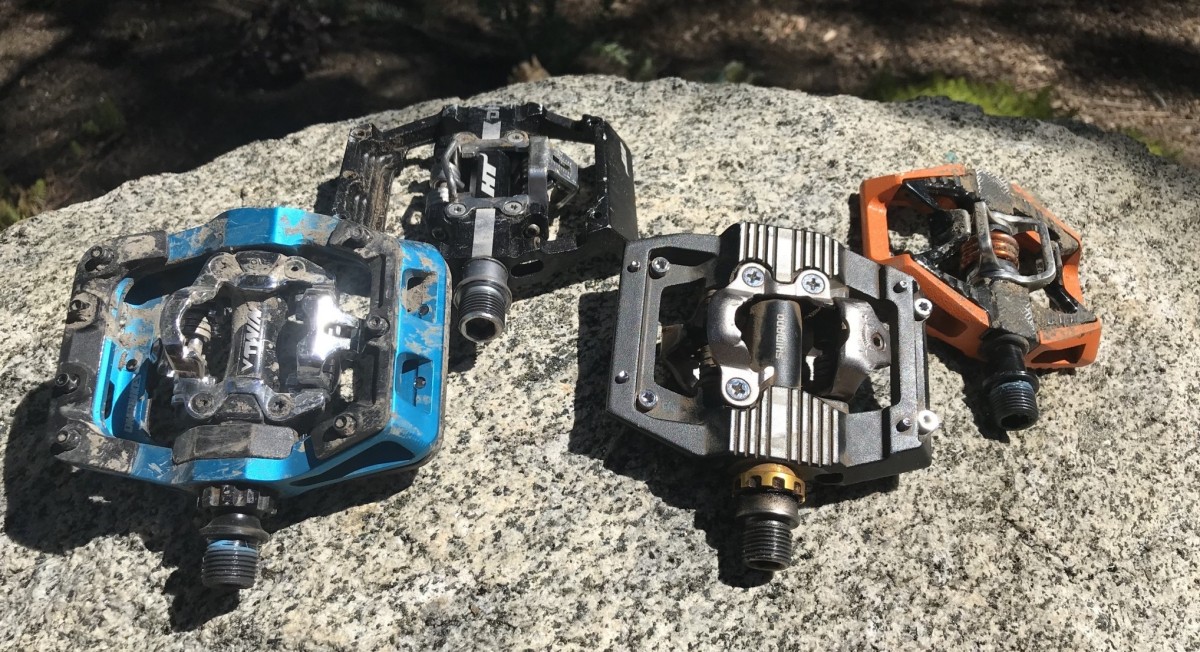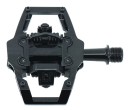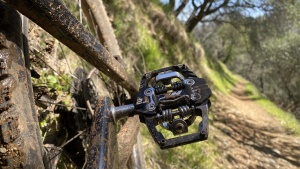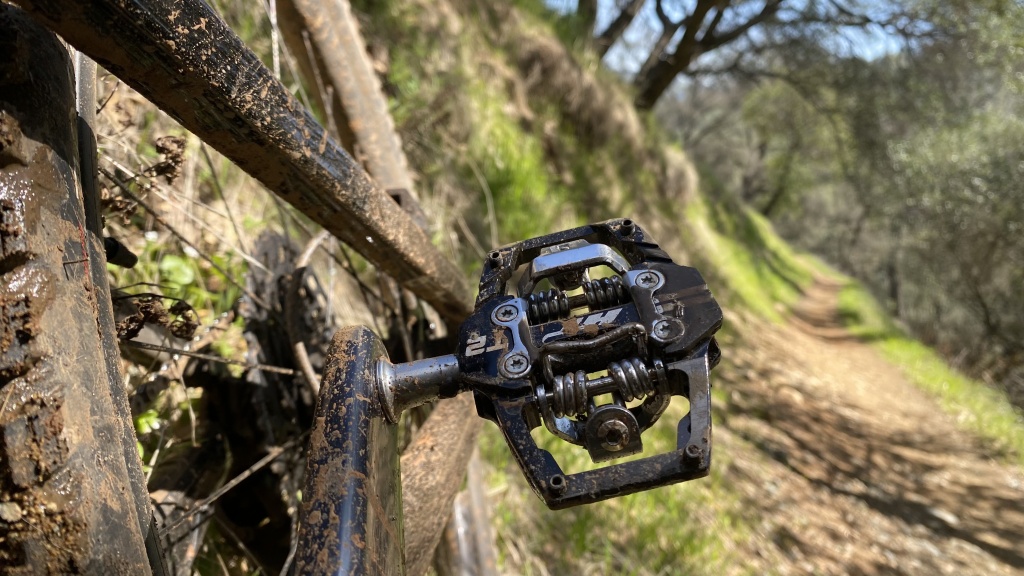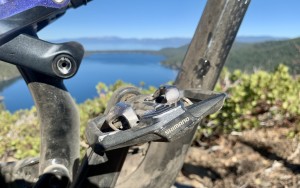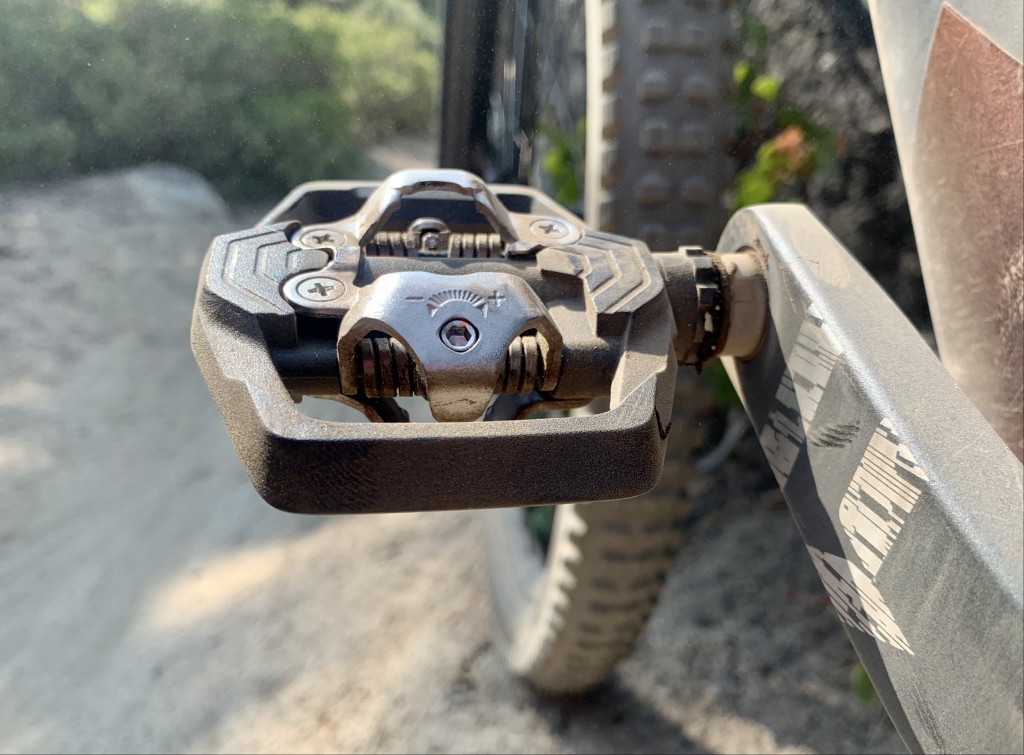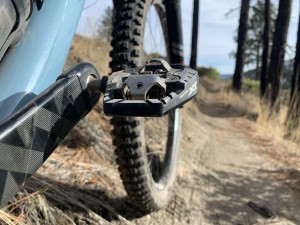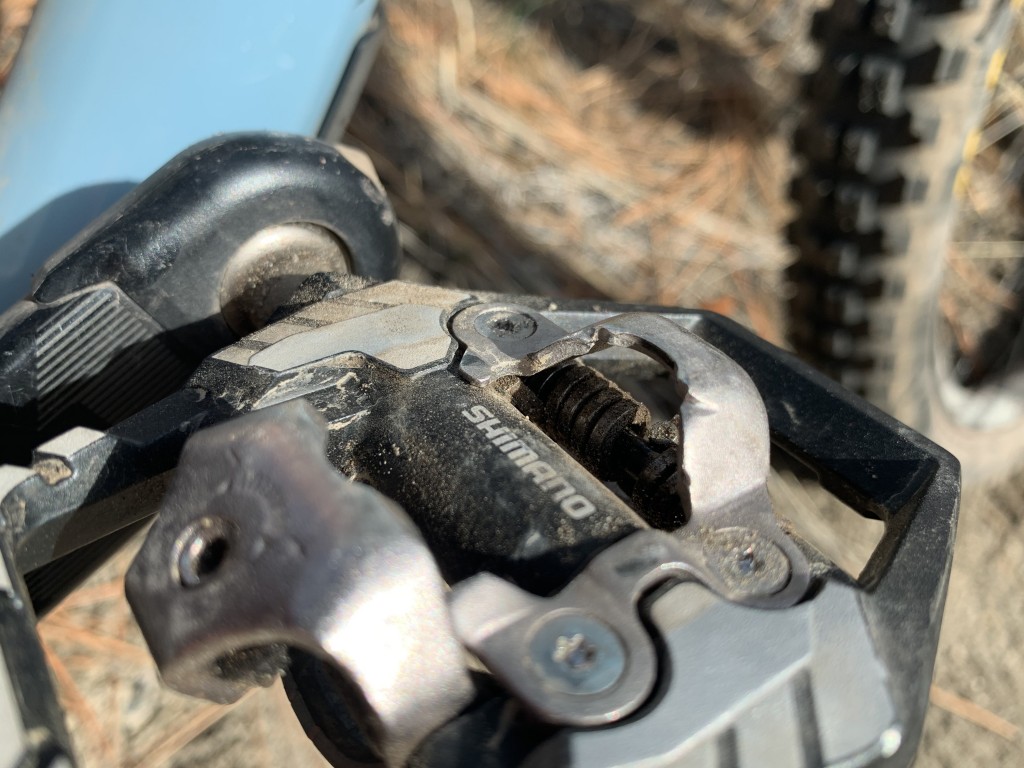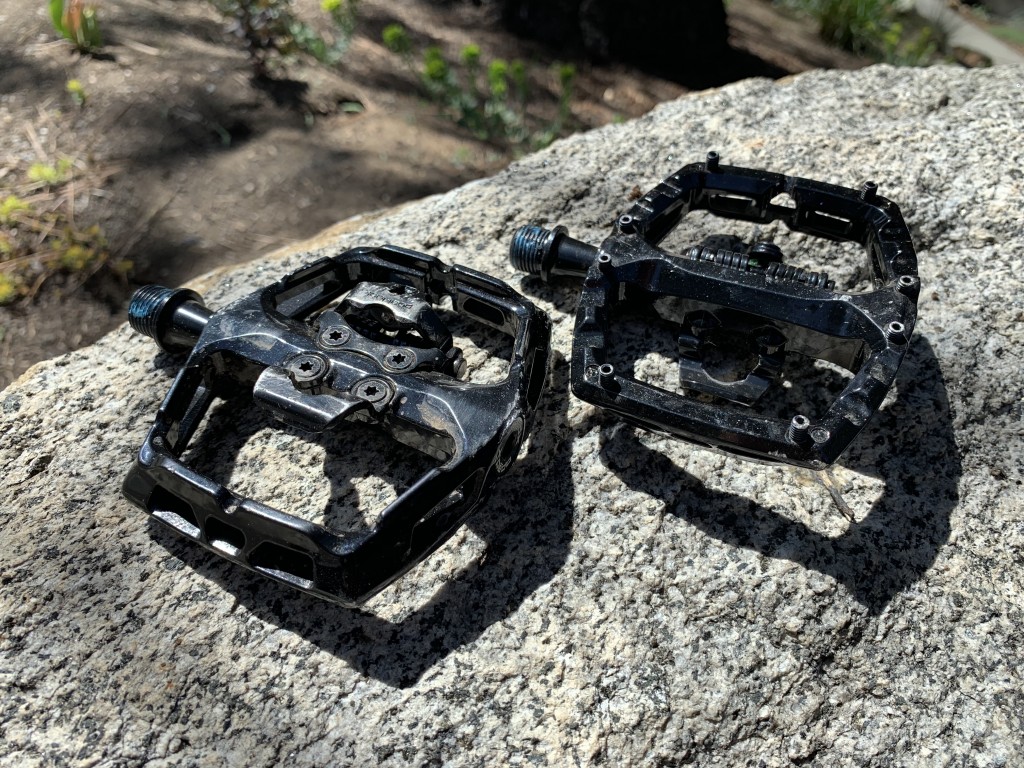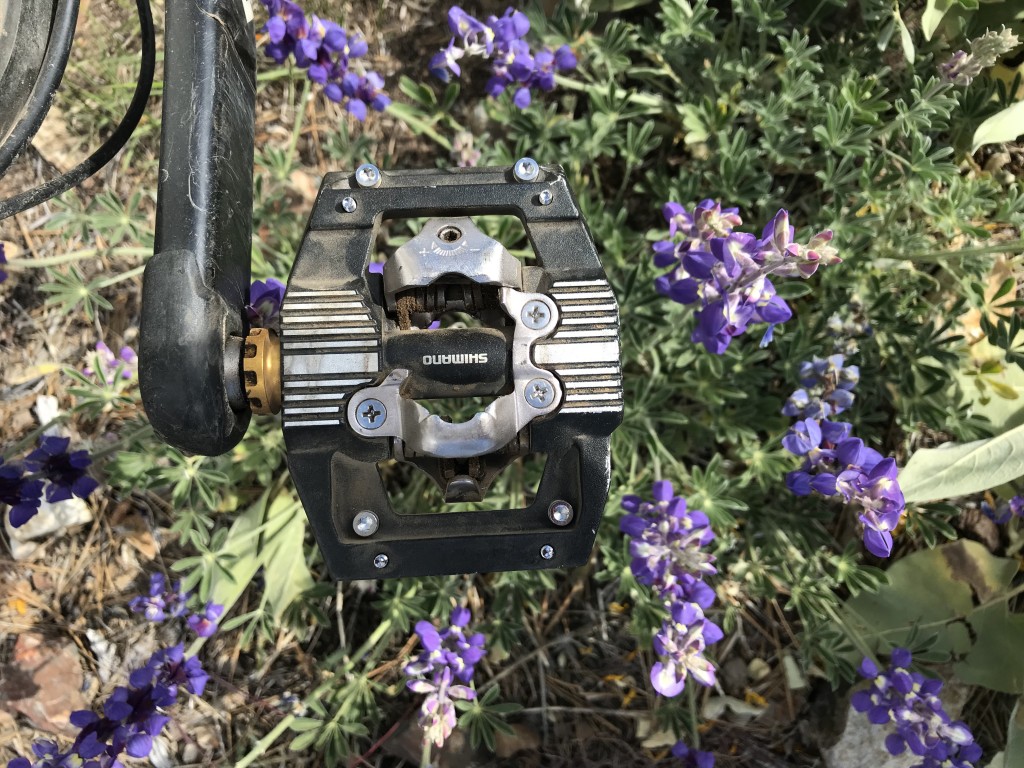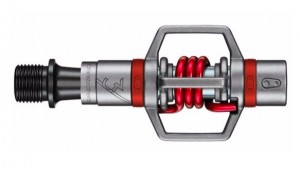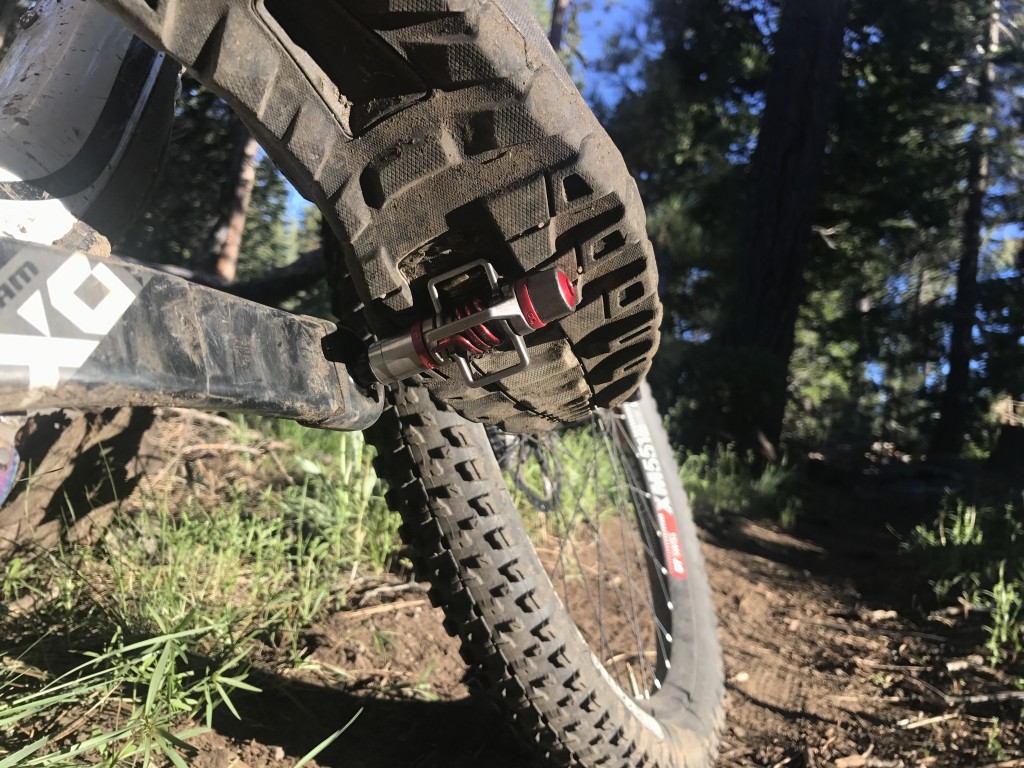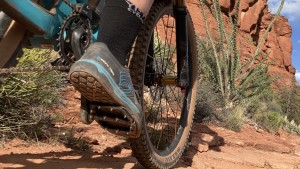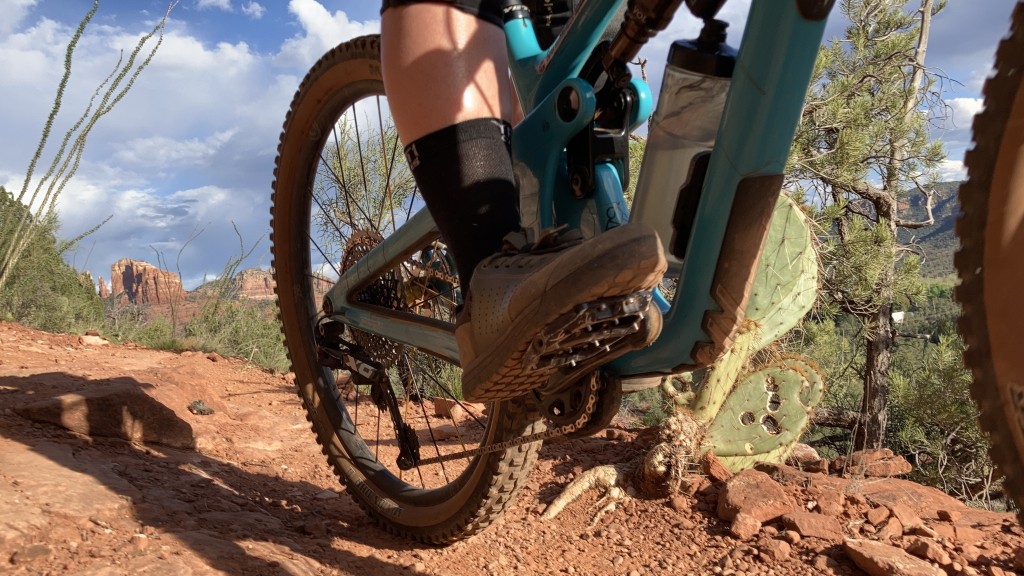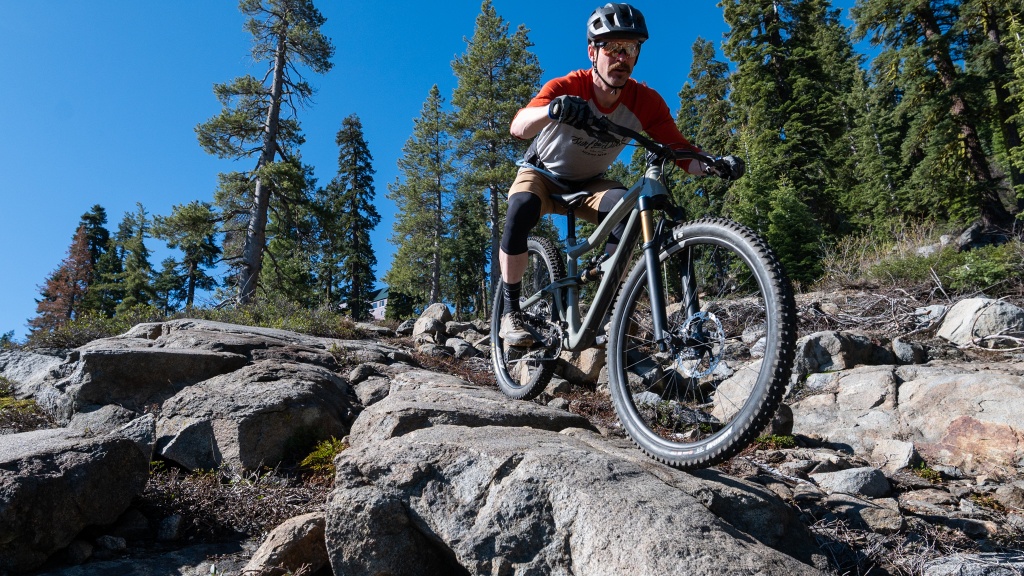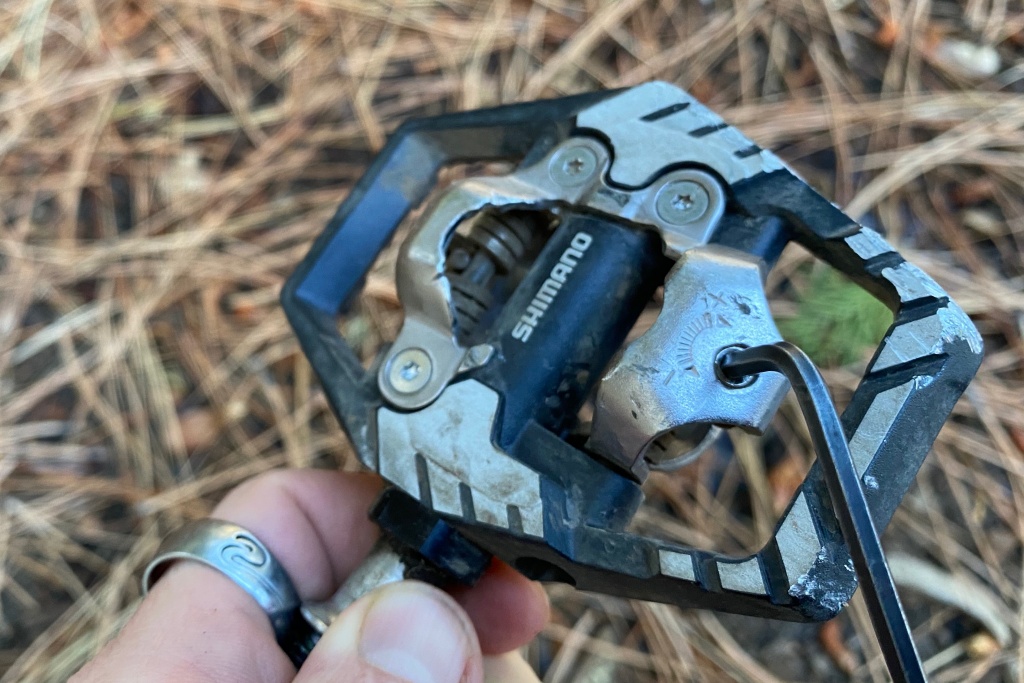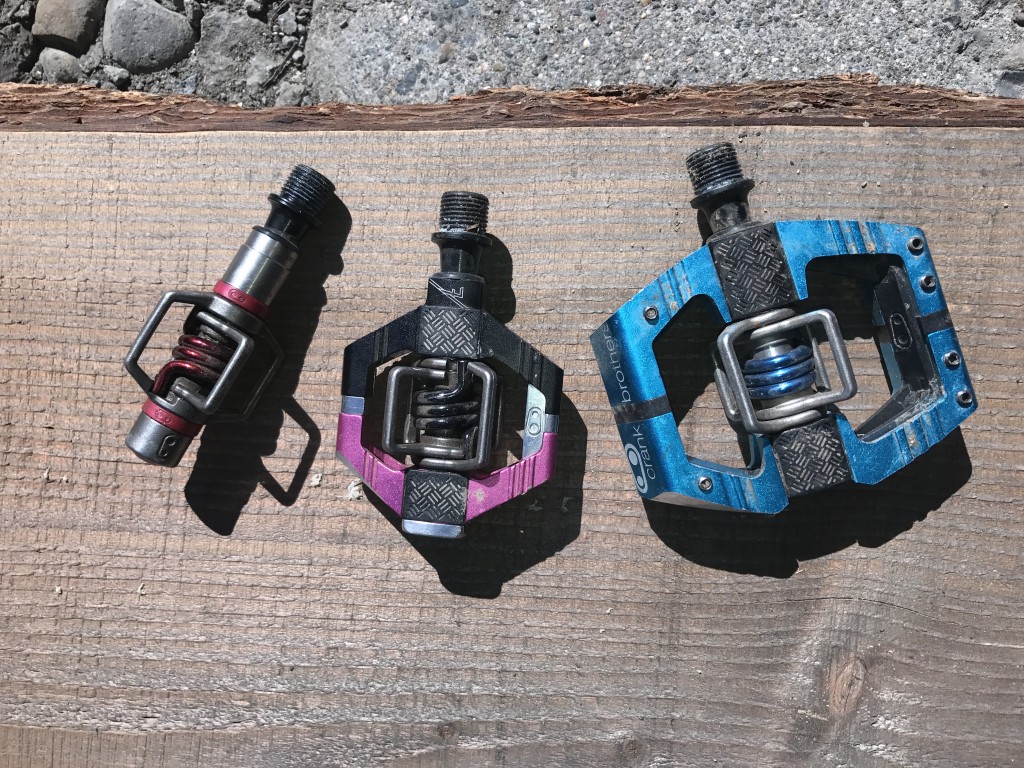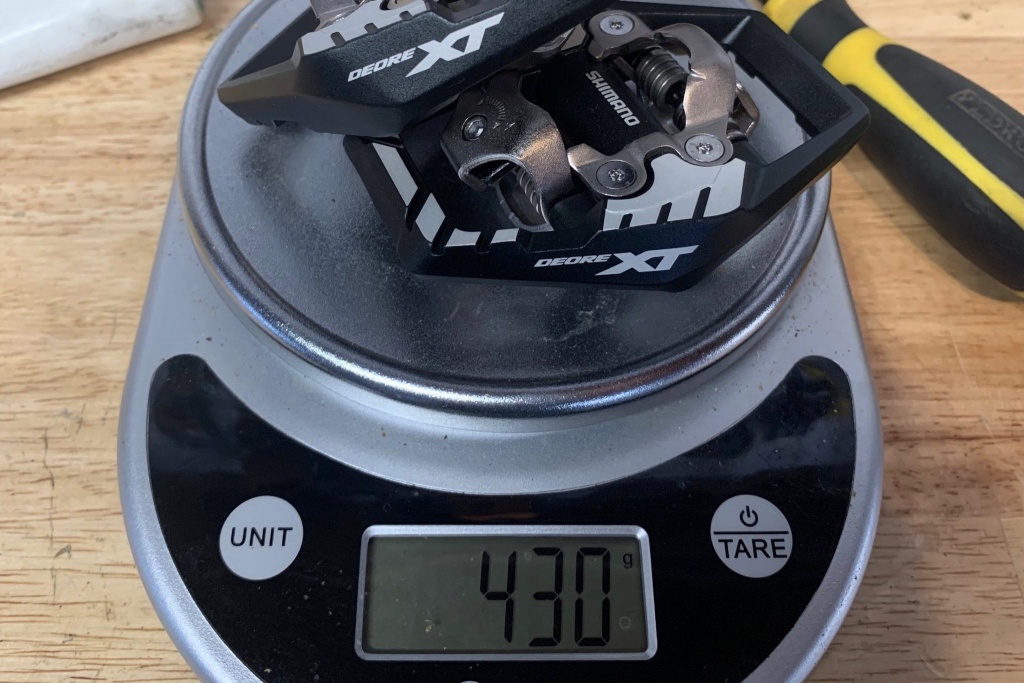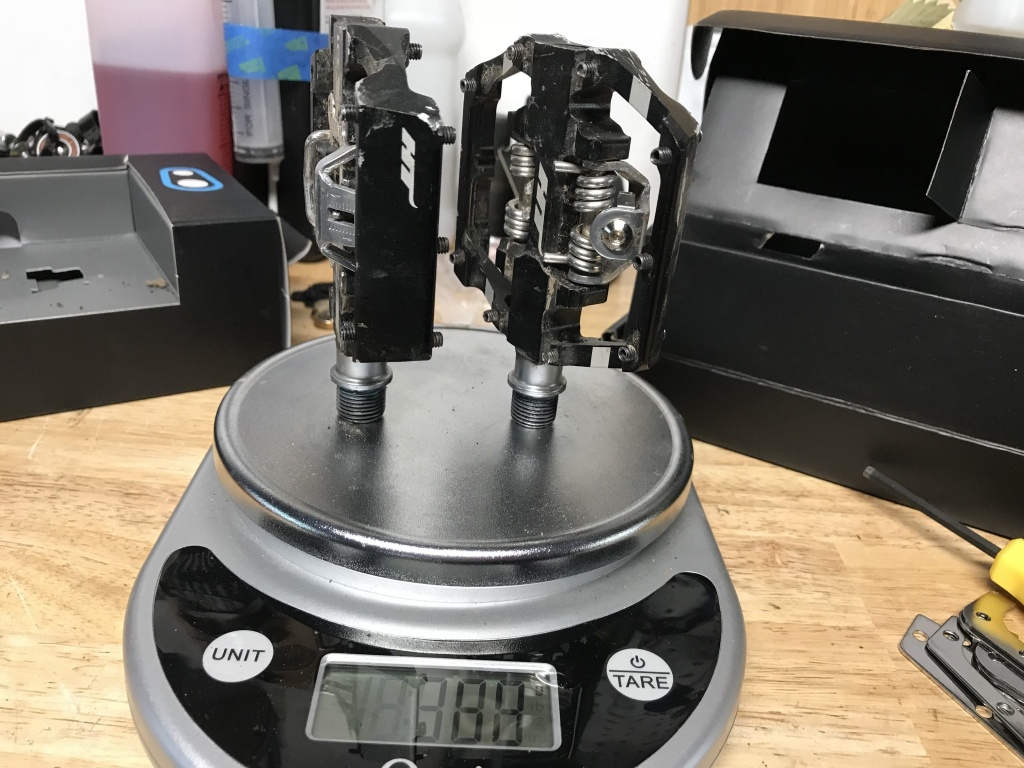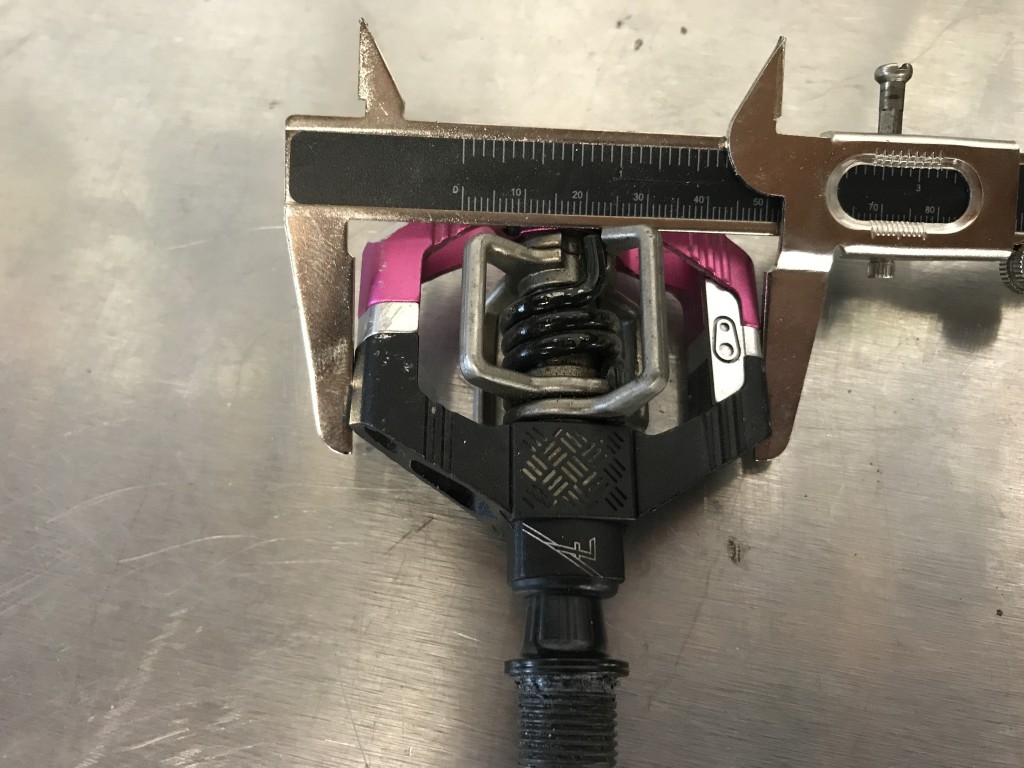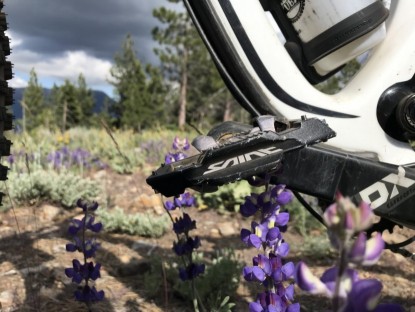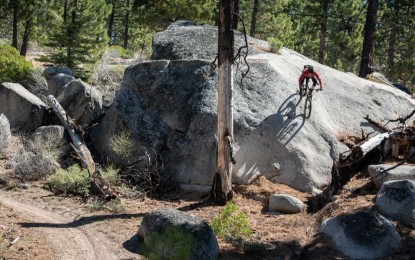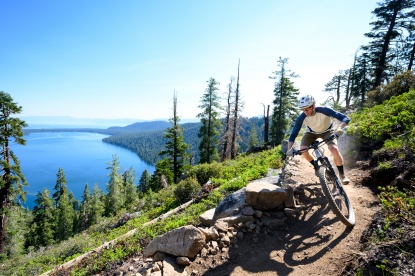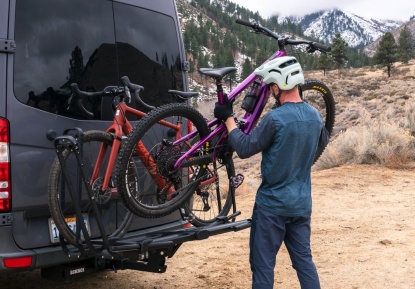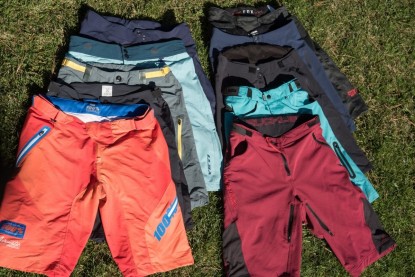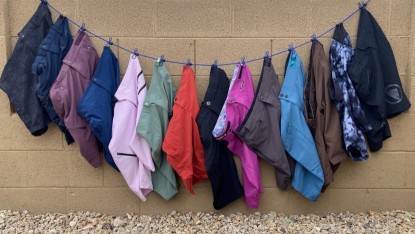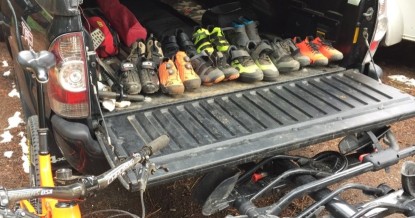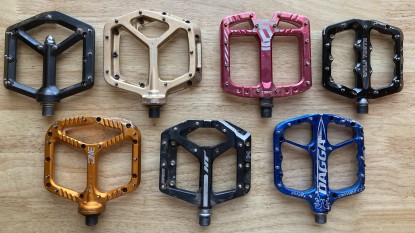Over the past eight years, we've purchased and tested dozens of pairs of clipless pedals to find what works best for mountain biking in all conditions. This current selection shows our favorite 20 pairs of pedals, each offering a compelling mix of performance and value. We have assessed each model based on its ease of entrance and exit, adjustability, mud-shedding ability, weight, platform, and durability. We have recommendations for everyone, no matter what their budget, preferences, or riding style may be. We also have a review of the best mountain bike flat pedals as well as a broader review of the best bike pedals of all types.
Editor's note: This review was updated on March 26th, 2024, with updated testing data and some thoughts from long-term testing.| Awards | |||||
|---|---|---|---|---|---|
| Price | $172 List $174.28 at Amazon | Check Price at Backcountry Compare at 3 sellers | $130.10 at Amazon Compare at 2 sellers | Check Price at REI Compare at 2 sellers | Check Price at Backcountry Compare at 4 sellers |
| Overall Score | |||||
| Star Rating | |||||
| Pros | Adjustable, excellent performance, available in an array of colors | Silky smooth float, lightweight, great mud shedding, additional platform width | Lightweight, low profile, available in 2 different axle lengths | Stable, great power transfer, excellent traction while engaged, inexpensive | lightweight, adjustable, low profile, inexpensive, available in many colors |
| Cons | Hefty, expensive, pins don't provide much traction | Expensive, rear platform is under utilized, questionable durability | Narrow platform, expensive, not recommended for trail or all-mountain riding | Heavy, sharp pins are a hazard to everything but your shoe | heavier cleats that are less ubiquitous, float isn't SPD smooth |
| Bottom Line | Large, heavy and adjustable, this pedal will find its audience, but its price to performance ratio isn't in line with its competitors | Top of the line offering from Shimano, they're silky smooth, adjustable and renowned for their consistency | A highly evolved, race proven pedal that provides exceptional stability for its size | A big step up in stability and traction, we find them worth their extra weight | Lighter, less expensive and more adjustable than their Shimano competition while offering better mud shedding and traction |
| Rating Categories | DMR V-Twin | Shimano XTR M9120 T... | Shimano XTR M9100 Race | Shimano Saint SPD M820 | HT Components T2 |
Ease of Exit (25%)  |
|||||
| Ease of Entry (20%) | |||||
| Adjustability (20%) | |||||
| Weight (15%) | |||||
| Platform (10%) | |||||
| Mud Shedding Ability (10%) | |||||
| Specs | DMR V-Twin | Shimano XTR M9120 T... | Shimano XTR M9100 Race | Shimano Saint SPD M820 | HT Components T2 |
| Weight per Pair (grams) | 610g | 397g | 314g | 550g | 380g |
| Weight of Cleats and Bolts (grams) | 54g | 51g | 51g | 50g | 62g |
| Cleat Type | SPD style mountain replica | SPD mountain | SPD mountain | SPD mountain | HT X1 cleats |
| Style | mini-cage | no cage | no cage | mini-cage | mini-cage |
| Platform Dimensions (lxw) | 107 x 82mm | 100 x 71mm | 71 x 68 mm | 100 x 79mm | 83.5 x 68mm |
| profile height | 20mm | 17mm | 17mm | 19mm | 17mm |
| Q-Factor | 55mm | 56mm | 56mm | 57mm | 56mm |
| Total Width from Crank Arm | 95mm | 91mm | 84mm | 95mm | 90mm |
| Entry | 2-sided | 2-sided | 2-sided | 2-sided | 2-sided |
| Adjustable Tension | yes | yes | yes | yes | yes |
| Traction Pins | 7/side | 0 | 0 | 4/side | 8 grub pins |
| Bearings | sealed and serviceable | dual angular contact, metal retainer | dual angular contact, metal retainer | dual angular contact, metal retainer | Stainless Steel sealed cartridge bearings |
| Cage Material | extruded / machined aluminum | annodized aluminum | annodized aluminum | forged and machined aluminum | extruded/CNC machined aluminum |
| Pedal Wrench Type | 6mm allen | 8mm allen | 8mm allen | 8mm allen | 8mm allen |
The Best Mountain Bike Pedals for 2024
Best Overall Mountain Bike Pedal
HT Components T2
The HT T-2 is a high-quality, low-profile, mid-cage clipless mountain bike pedal that came out on top at the end of our test period. This pedal is built tough enough for the rigors of enduro racing but is lightweight enough to consider for your XC or trail bike. Its wide platform, equally spaced grub pins, and adjustable clipless mechanism make for quick, solid engagement and predictable release. With the lowest profile height in our test, these pedals boast a sizeable surface area to interface with the soles of your shoes, giving excellent lateral stability and control. They feature a minimalist engagement mechanism, allowing for efficient mud shedding. The pedals come with two sets of cleats; the X-1 cleats provide 4 degrees, and the X-1F cleats provide 8 degrees of lateral float to suit your preferences.
The CNC machined Chromoly steel axles of the T-2 are supported by precision stainless sealed bearings and IGUS bushings. The pedal bodies are made of extruded and CNC machined aluminum and come in an array of anodized colors, including stealth black, which has an anodized black clipless mechanism and spindle. Quality and efficiency do not come cheap, but these pedals are reasonably priced and feel like an excellent value after a year of testing.
Read more: HT T-2 review
Best Bang for the Buck
Shimano ME700
The Shimano ME700 is anentry-level small platform pedal with a reasonable price. They look and perform similarly to the higher-end XT and XTR siblings but cost considerably less. This pedal replaces the tried and true M530 and features the same durable, adjustable, and reliable Shimano SPD clipless mechanism. Entry and exit are easy and consistent, with a wide range of release tension adjustments. The ME700 has a mid-size platform that surrounds the clipless mechanism, devoid of the machined surfaces found on their higher-end cousins. The small cage helps to orient the pedal and provides additional width for added lateral stability.
The primary disadvantage of the ME700' is the weight. They're not massive at 482 grams per pair, but most weight-conscious riders will want to look elsewhere. The painted pedal body finish is more prone to retaining mud and will wear faster than the anodized finishes found on higher-end versions. Aside from those reservations, we found little to dislike about this flexible and reasonably priced pedal.Read more: Shimano ME700 review
Another Great Trail Riding Pedal
Shimano PD-M8120 XT SPD
Shimano's most recent version of the XT Trail pedals, known as the M8120 XT, maintain the legendary XT durability the group is known for. They kept the previous version's dependable and predictable performance while slimming the pedal's profile and enlarging the overall platform. This resulted in more shoe-to-pedal touch and a greater sense of stability and control. With the tried-and-true SPD retention mechanism and cleats, entry and departure stay as predictable as ever. This pedal is excellent for anyone seeking consistent entry and release with a large platform, from enduro racers to hardcore XC trail riders. The M8120 is also a fantastic buy when you consider the longevity and performance of these pedals.
We liked most aspects of Shimano's new M8120 XT pedals, but one flaw was difficult to ignore. When tightened to the suggested torque specification, the hexagonal locknut by the spindle tended to protrude above the level of the pedal body. As a consequence, there was some interference with the shoe/pedal interface. In addition, the new version is a touch heavier than the prior one. Aside from that, our love affair with the XT Trail pedals continues, particularly with the new version's improvements and updates. At GearLab we have several pair that rotate through bike testing and we could only wish that other parts were as durable and reliable.
Read more: Shimano PD-M8120 XT SPD review
Best Dual-Function Clipless and Flat Pedal
Xpedo Ambix
If you like to switch between clipping in and riding a flat pedal, we feel the Xpedo Ambix is the best dual-function pedal we tested. This model combines a full-featured, stable, and grippy flat pedal on one side with a lightweight and efficient mid-cage clipless pedal on the other. These versatile pedals are made with performance in mind, and the 6061 aluminum pedal body and Chromoly axles roll on three sealed cartridge bearings. Similar to a standard clip-in pedal, the clipless mechanism on this pedal uses a wide opening for easy entry and exit. It features a fixed front cleat holder and a spring-loaded rear for secure retention. The cleat retention force is adjustable, and the included XPC cleats allow for 6 degrees of float. The flat side of the pedal features eight nicely spaced and adjustable grub pins. If you're seeking clipless performance some of the time and want the option to ride a flat pedal other times, the Ambix does well at both.
The pedal's platform size and pin placement work well with a clipless shoe and aren't too noticeable when pedaling on that side. We liked how you could ride either side of the pedal and forget it had another purpose. The Ambix fills a need for a pedal that can allow a clipless rider to back off from a risky scenario or add efficiency to a flat pedal rider's haul up the hill. Our only true complaint is that orienting the pedal when clipping back in with the mechanism on only one side of the pedal can be less user-friendly.
Read more: Xpedo Ambix review
Best for Enduro and Downhill Riding
Shimano Saint SPD M820
If you care more about your trail, enduro, or gravity bike's performance and stability than how much it weighs, you should check out the Saint M820. These gravity-focused pedals were stable and confidence-inspiring on the trail. The Saint is a brick-shaped, fixed mechanism, clipless platform pedal with four traction pins on each side. The forged pedal body is burly and appropriate for the rigors of gravity-focused riding. The platform is massive, helping you engage quickly and giving you a more secure, stable footing and excellent lateral support. We prefer the Shimano Saint M820 to its closest competitors in this test because they're slightly smaller, lighter, and have a lower profile height.
The Saint pedals aren't light, and adding them to your bike may add some weight compared to lighter versions. The platform is also quite big, which may result in more pedal strikes for riders who frequent particularly rough terrain. They are the best choice for riders who frequent shuttles and lifts; they're ubiquitous in the gravity crowd.
Read more: Shimano Saint M820 review
Best for Weight Savings
Crankbrothers Eggbeater 3
Cross-country riders and racers or those seeking the lightest weight gear will most appreciate the Crankbrothers Eggbeater 3. At only 280 grams, they're the lightest weight mountain bike pedal in our review. Named for their striking resemblance to an eggbeater, their unique, open design made them the top performer in our mud-shedding test. They refuse to clog and allow entry on all four sides of the pedal. They also have a floaty feel that can take some getting used to but may help alleviate knee strain for some users.
The Eggbeater 3 is the smallest of the pedals tested, and we do not suggest them for beginners or those unfamiliar with clipless pedals. While not difficult to engage, the small cage requires skill and patience to get your foot lined up. They also have zero platform, so they should only be used with very rigid-soled shoes, and they don't offer the lateral stability found in other clipless pedals.
Read more: Crankbrothers Eggbeater 3 review
Best Overall Flat Pedal
Wolf Tooth Waveform
Weight per pair: 373-grams | Traction Pins: 11 per side
There is a lot of competition in the flat pedal market, and the Waveform crushed it. The dual concave platform gives feet a remarkably natural feeling underfoot, and as one of our testers put it, “It just feels right.” In our parameters for grip, traction, platform, mobility, and weight, these pedals performed remarkably well. 11 bottom load traction pegs on the Waveform offer excellent grip with various shoes and keep your feet firmly in place on chunky climbs and descents. Small and big sizes of the Waveform are available so that you may select the proper fit for your foot. Even with sticky rubber shoes, shifting the foot is simple. The three fully sealed, low-friction cartridge bearings spin predictably and smoothly, preventing your pedal from spinning away from you as you pull your foot off. Tapered edges and a somewhat reduced width reduce the likelihood of rock impacts, which we prefer on rocky routes. It just takes ten minutes and three different-sized Allen keys to service the pedals, but it is simple. The replacement of the bearings is possible without using specific tools, unlike many pedals.
The Waveform's pricing is its main flaw. The pedals, however, are entirely rebuildable, and Wolf Tooth's website sells new parts. This is known as the “Right to Repair.” The Waveform is a wonderful choice if you're searching for a pedal to take you from cross-country loops to the bike park and everything in between.
Read more: Wolf Tooth Waveform review
Best Overall Composite Flat Pedal
OneUp Components Composite
Weight: 359-grams | Platform: 114 x 104mm
The reasonably priced OneUp Components Composite flat pedals impressed our testers. It is a composite-bodied version of the more expensive Aluminum pedals, and they boast decent levels of grip with ten well-spaced pins per side to bite into your soles. These lightweight pedals have a good mid-sized platform of 114 x 104 mm and work well with a large range of foot sizes and they are relatively low profile to help avoid rock strikes. The composite pedal body feels rugged and durable and will likely endure years of abuse. While they don't have the most tenacious grip, they are the grippiest among the composite models we tested. The pedal has good controlled mobility and doesn't spin freely on its axle. They are also relatively easily serviceable, and pin and bearing kits are readily available.
The Composite is an excellent flat pedal option for the price. That said, they don't provide the same levels of grip as some of the more expensive competitors. They grip quite well for the price, and they are a great option for those just starting out or anyone operating on a budget.
Read more: OneUp Components Composite review
Compare Products
Why Trust GearLab
Author and lead tester Joshua Hutchens is a mountain bike veteran who has held almost every job in the bike industry. From shop gopher to shop owner, bike guide to bike coach, Joshua has led cycling trips worldwide and competed in every discipline he has discovered. He rides like Lionel Richie sings and has a meticulous and analytical approach to testing.
We tested these mountain bike pedals in the Sierra Nevada mountains. We search out nasty, technical terrain, take the big lines, smash obstacles and ford streams, and occasionally, we stop for pictures. These aren't the pedals you want to buy second-hand once we're through with them. We carefully scrutinize their performance and rank them based on predetermined metrics. We evaluate them for ease of entry, ease of exit, overall adjustability, weight, platform feel, and how well they can shed mud. We fret over the results so you can kick back and read about it.
Types of Pedals
There is no shortage of things to consider when buying a pair of mountain bike pedals. There are many different types of pedals for different styles of bikes and riding. You'll first need to decide if you want to clip into clipless pedals or ride on flats. This review focuses on the full spectrum of clipless mountain bike pedals.
Analysis and Test Results
There are few things as exciting as buying a brand-new bike. New bikes, however, rarely come with pedals. Although a seemingly minor part of the bike, you can't really ride without them. When considering a new bike purchase, we recommend thinking ahead and buying pedals in advance if you don't already own a set. It's also a great time to get some new shoes so you can optimize your connection to your new bike. Likewise, upgrading or replacing your old pedals can enhance your bike's performance and your riding experience.
Value
We don't rate the products we test based on their price, but we always appreciate a good value. Price and performance often go hand in hand, but that is not always the case. The Shimano ME700 and M520 are great values. They're roughly a third of the price of the pedals that score higher. The 520 is less expensive than the ME700, but it has a small platform and isn't as easy to engage. We feel the ME700 is a better all-around option for most mountain bikers. Another great value is the Shimano Deore XT M8120. It scores just behind the HT T-2 but typically sells for considerably less.
Ease of Exit
Ease of exit refers to how easy it is to unclip your foot from the pedal. If you're unable to unclip when you want to, it can create an unsafe situation that may result in the rider falling over in awkward and sometimes dangerous ways. As such, we weighted this metric a bit heavier than others. Unclipping isn't something you do only at the end of the ride; technical sections and loose corners often call for a quick foot dab to maintain balance.
Generally speaking, the easiest pedals to exit are those with the least amount of obstruction or interference. Some of the newer pedals without traction pins are easier to disengage because there's nothing for your shoe to hang up on when unclipping. Those with multiple grub pins and larger cages can create obstacles to getting your foot free.
Some of the models that can be more challenging to get out of were those with lots of floatation. Floatation refers to the number of degrees you have to twist your foot before the cleat releases from the retention mechanism. If too much heel movement is required to disengage, the toe of the shoe can engage the crank arm before the cleat releases. The Shimano XTR M9120 and XTR M9100 pedals were the easiest to exit. The M8120 XT is right up there with its more expensive siblings. These above-mentioned Shimano pedals have four degrees of float and no traction pins. The Time ATAC XC 8 was the most difficult pedal to disengage as it has 13 or 17-degree release angles. Though the Crankbrothers have 15 or 20-degree releases, we still found them easier to get out of than the Time pedals.
The Time and HT pedals are the only pedals in the test to use lateral float, which allows your foot side to side movement. While often touted as beneficial for those with existing knee issues, we didn't feel the consistency of release was worth the potential upside. It wasn't just the full range of motion that made them difficult — it was the lack of consistency.
The Time pedals feature a front arch that is responsible for release tension. If you're pedaling or standing on the pedals with toes pointed downward, you're exerting pressure on the release spring. This can create an inconsistent release which makes them hard to trust. The HT pedals have spring tension on both sides of the engagement mechanism and considerably less float, which is less troublesome but still doesn't provide perfect consistency.
Ease of Entry
This metric assesses how quickly and easily a rider can clip into a pair of mountain bike pedals. This is important because it determines how fast you can start pedaling your bike. Ideally, clipping in should be a simple process that doesn't require too much thinking or effort so you can focus on the trail and on not falling over.
Engaging the Shimano or Xpedo models requires little effort and produces an audible click. This helps you know that you're engaged and ready to roll. Clipping into the Crankbrothers or Time pedals doesn't reliably produce the same audible confirmation. There is a dull, somewhat vague sound that often accompanies the engagement but not always. Overall, most of these pedals are relatively easy to engage but knowing that you're securely clipped in aids in confidence.
The mini-platform pedals are the easiest to engage in. The extra bit of material helps guide your feet, and kicking the cage flattens them out underfoot, putting them in the prime spot for engagement. We rated the HT T-2, Shimano XTR M9120, and the Shimano XT M8120 highest in this metric. The Shimano XTR M9120, with its long body, felt almost magnetic with the cleat. In contrast, the small Time ATAC and Crankbrothers Eggbeater pedals were a harder target to hit, and when you did, the pedal wasn't always oriented perfectly for engagement.
On the other end of the spectrum, the large-bodied Crankbrothers Mallet E and HT D1 were easy to find and orient, but their sticky traction pins could hang up on your sole and complicate the engagement process.
Adjustability
Adjustability refers to how much we could change the feel and function of each pedal. Some pedals allow us to adjust their release tension. Some allow for different degrees of float (that is, how much you can move your foot around or float side to side before the cleat releases). Others have adjustable pads or pins that interface with the sole of the shoe creating friction or helping to orient the pedal for engagement.
The most adjustable pedals are the DMR V-Twin, HT T-2, and XPedo GFX. These pedals feature adjustable tension, adjustable float, and had traction pins, allowing you to customize their performance in a variety of ways.
Some models we tested didn't allow us to personalize the feel or adjust for performance. The Crankbrothers pedals don't allow you to adjust the release tension, which is likely fine for the average rider. Beginners and lightweight riders, however, may benefit from less release tension and an easier exit from the pedal. Similarly, heavy or aggressive riders can lessen their chances of accidental release by having a pedal that can accommodate their level of force.
Release Tension
The Shimano, Time, DMR, HT, and Xpedo pedals all allow the rider to increase or decrease the effort required to release by adjusting the amount of spring tension holding the cleat. Crankbrothers pedals have a bit of a disadvantage in this regard because you can't adjust the tension.
FloatThe Time Speciale 8 cleats can be mounted to provide 13 or 17 degrees of float, depending on their attachment orientation. Time also sells an easy cleat that allows for 10 degrees of float. The Crankbrothers standard cleats provide 6 degrees of free float and a 15 or 20-degree release angle based on how they're mounted (more on that below). Crankbrothers also offers a zero-degree or no-float cleat that is intended to enhance pedal efficiency. The Xpedo cleat allows for six degrees of float, and the Shimano cleats provide four degrees. Shimano sells a multi-release cleat that allows for release in any direction without changing the float, a great option for beginners. The HT T-2 includes two sets of cleats that offer 4 or 8 degrees of lateral float.
Traction Pins and Pads
The traction pins (or grub pins) on the HT T-2, Time Speciale 8, and Look X-Track En-Rage Plus are all adjustable. These pins provide traction while unclipped and can be raised or lowered by threading them up or down. Lowering the pins makes the pedal feel less aggressive, with less bite into the sole of the shoe. Raised pins engage the soles more, particularly on soft rubber shoes, but can complicate entry and exit to the engagement mechanism.
The Crankbrothers Candy 7 and Mallet E pedals feature textured traction pads. These pads are polyurethane bumpers that sit adjacent to the cleat interface on the pedal. Both models include 1mm and 2mm thick pads, and swapping them out will create more or less interface between the shoe and pedal platform. The thicker pads offer more resistance to float, and the interchangeable pads allow you to customize the pedal to your specific shoe. The DMR V-Twin uses nylon bumpers that sit fore and aft of the cleat mechanism under the traction pins. Spacers beneath the bumpers will raise the pads and pins toward your shoe. Some pedals also include thin, 1mm cleat spacers that push the cleat further from the sole of the shoe, lessening the friction between the shoe and pedal.
You can also adjust the feeling of the Crankbrothers by swapping the orientation of the cleats on your shoes. There is a small indentation on just one cleat. If you mount the cleat with this indent on your right shoe, you will have a 15-degree release angle. If the cleat with the indent goes on your left shoe, you will get a 20-degree release angle.
Weight
Weight is an important metric for certain riders and riding styles. Those who prefer pointing their bikes downhill while gravity does most of the work probably don't mind adding a few ounces here and there, particularly when there is a performance benefit. Cross-country riders and racers, on the other hand, tend to be more weight conscious. The less weight you're pushing, the faster you can go and the fewer calories you expend. For many riders, though, there are criteria more important than weight — performance and value come to mind.
The heaviest clipless pedals we tested are the DMR V-Twin, at 610-grams, and the lightest pedals are the Crankbrothers Eggbeater 3, at 280-grams. When you factor in the additional weight of their cleats, it's a 351-gram difference between the two. That's a significant weight difference between two parts that perform roughly the same function. In general, the manufacturer's stated weights corresponded closely to the weights we observed on our scales. When that's not the case, we take note and list our observed weights. The HT T-2 weighs in at 380-grams for a high-performing pedal with a mid-sized cage. For comparison, one of our other most highly rated mid-cage pedals, the Shimano XT M8120, weighs in at 430-grams, nearly 60-grams heavier. Many times, price and weight go hand in hand. For example, the Shimano ME700 costs significantly less than the XT-M8120 and weighs 52-grams more.
Mud Shedding Ability
We evaluated how well each pedal sheds mud and resists jamming in muddy conditions. The muddier the trail, the more likely you are to put a foot down. When this happens, mud gets transferred to your cleats and the pedal and may clog up the clipless mechanism. The best mud shedding pedals have some way of evacuating mud to allow engagement. Simple designs are often rewarded here.
The HT T-2, with its wide-open design, is well-built for the challenges of mud and sloppy conditions. The Shimano XTR M9100, with its conically machined platform, also did remarkably well when our soles and cleats got muddy. Surprisingly, the Time Speciale 8, with its solid body design, does incredibly well and is renowned for its ability to keep riders going through the slop. Like the HT, the Time pedal employs a minimalist front clip that leaves nowhere for mud to hang on.
Pedals like the Xpedo GFX and the Crankbrothers Double Shot 3, with lots of surface area, were notably worse on wet trails. Both accumulated mud as we rode.
Platform
We analyzed how effectively the presence or absence of a platform surrounding the clipless mechanism supports performance. The pedals in this test vary widely in the amount of platform provided, and there are advantages and disadvantages to more surface area. If you're spending your time in the saddle hammering away at the pedals with stiff shoes and not riding much technical terrain, a platform might be of little benefit. However, a platform becomes more important when you find yourself on more demanding terrain, which can often require more body movement and frequent unclipping. Pedals with small platforms like the Eggbeater 3 are lightweight and resist mud well but don't provide much lateral support for the foot.
A larger platform increases your feeling of stability and gives your feet more control. The Shimano Saint M820 and HT T-2 both offer wide, stable surfaces that are easy to find with your foot and are less likely to roll beneath your shoe. Likewise, the Shimano XT M8120, XTR M9120, and ME700 also provide a substantial platform that provides ample shoe/pedal contact and improved lateral stability and leverage. The downsides of the larger platform include added weight, increased incidence of pedal strikes, and more surface area for mud to accumulate.
Durability
To test durability, we rode these pedals hard. We bashed rocks and stumps and rode them in snow, rain, mud, and sand. We swapped them between many bikes and riders. In the several months we spent abusing these competitors, we found some unexpected issues with our XTR pedals. Shimano pedals have been renowned for their durability, often lasting a decade or more. The XTR M9100 and XTR M9120 pedals that we tested, however, all had their seals pop out by the third ride, and by the end of the test, they required readjustment. Interestingly, the new XT M8120 did not experience this same issue despite appearing to have a nearly identical design.
We've noticed throughout our riding careers that Crankbrothers, Time, and HT pedals all require rebuilds every year or two. They all sell kits for this, which generally cost around $25. The service process takes about an hour. Servicing a Shimano pedal's bearings, however, isn't typical. We have had many SPDs in our stables for years on end without servicing. Let's hope the latest generation of Shimano pedals hasn't changed that.
Conclusion
After countless miles on the single track and high-fiving until our hands hurt, we compiled our notes and data to tabulate which pedals are the best for which purposes and which ones are best left on the shelf. Whether you're crushing high alpine passes, counting ounces, or just looking for an affordable set to get you in the game, GearLab has you covered. It is our hope that this review will guide you to the pedals that not only mesh well with your shoes and bike but also fit your individual riding style. Happy trails!
Searching for more bike beta? We've tested a variety of mountain bikes and bike accessories over the last decade. If you're looking for flat pedals, our flat pedal review may also be of interest. We've tested top-rated mountain bike shoes for men and the best women's mountain bike shoes, as well as flat pedal shoes. We've also reviewed essentials such as half-shell helmets, our favorite bike racks, the best hitch racks, bike multi-tools, and more to get you outfitted for your next adventure.— Joshua Hutchens


